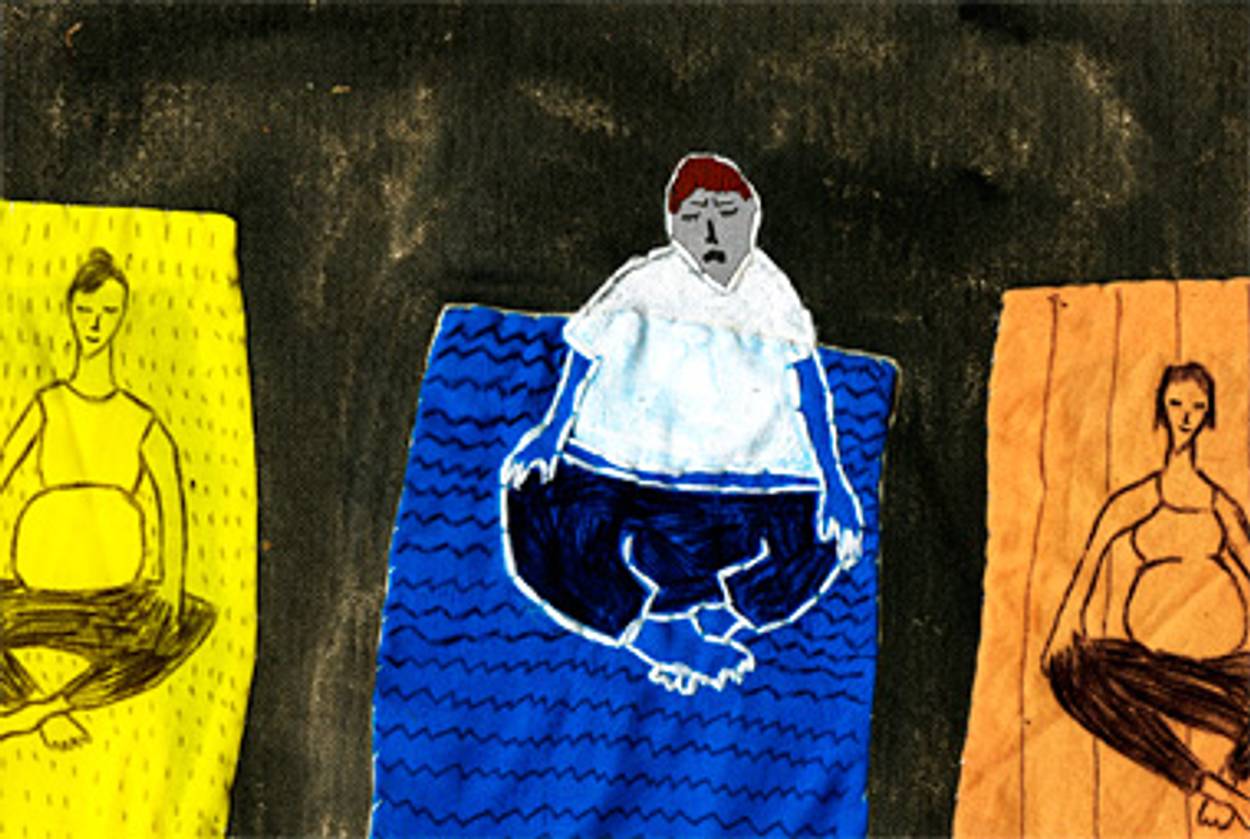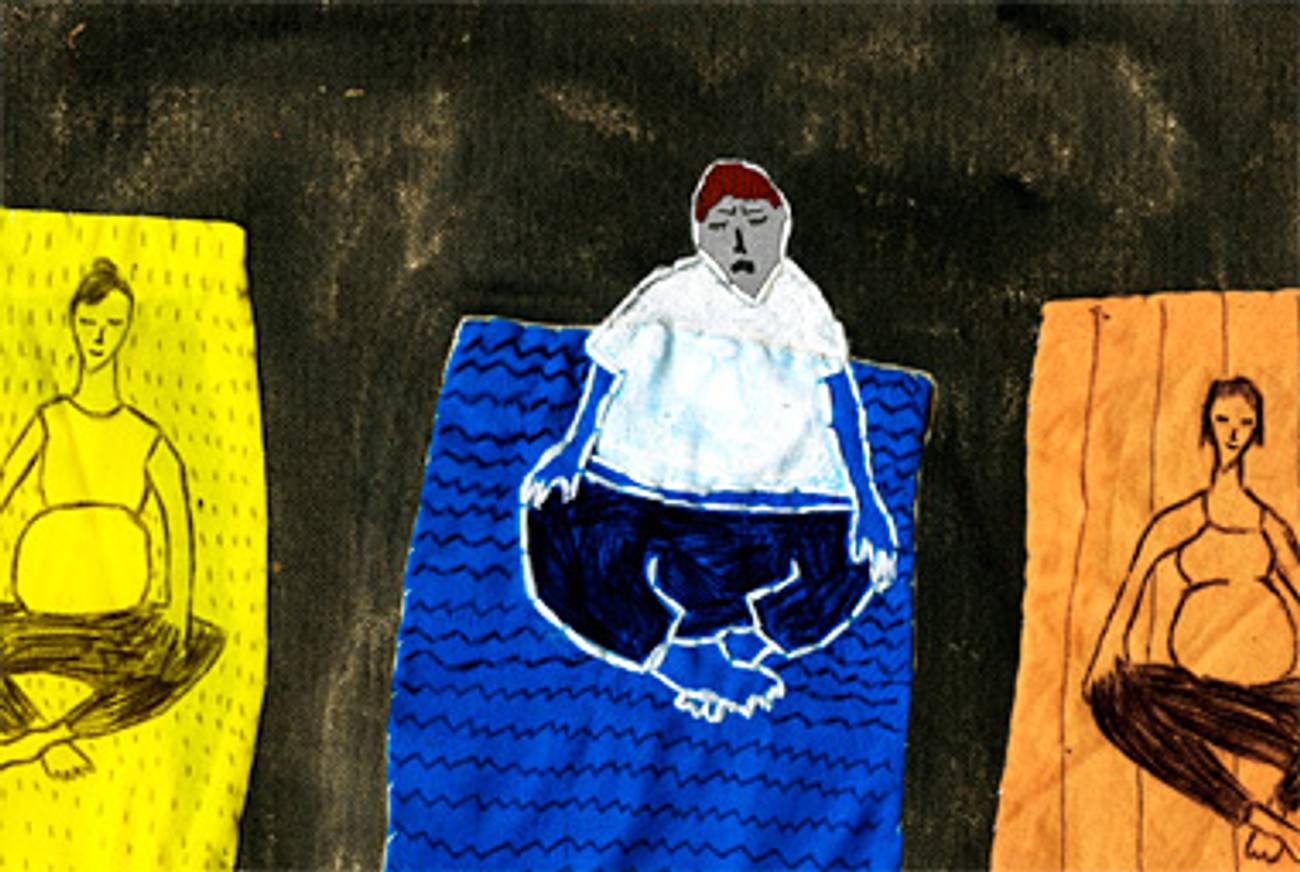Poser
When the middle-aged, out-of-shape male body finally begins to rebel, there are only so many reparative options for the devoutly sedentary. In praise of pilates and—of all things—prenatal yoga.




The media-blitzed revolution in Libya isn’t the only one going on in the region; there’s another revolution, quiet but no less significant, taking place, too. After more than 40 years of being oppressed by substandard nutrition and deprived of physical activity, my body has taken to the streets. My muscles—one after another, in remarkable synchronization—have begun to cramp. It started with my neck, moved down to my shoulders, and at some point even reached my feet. My wife came home one day to find me lying on my back like a dead cockroach. It took her 20 minutes to understand that something was wrong with me, and when she did, the first thing she said was, “You had it coming.” The second thing she said had to do with a bet she’d made with my cousin from Ramat Gan that I would die of a heart attack before I reached 50. According to my wife, his strong feelings for me were the only reason he agreed to risk money on my longevity, while she had common sense and modern medicine on her side. “Anyone treating a pet the way you treat your body would have been thrown in jail a long time ago,” my wife pointed out as she tried to help me sit up. “Why can’t you be like me—watch what you eat, do yoga?”
The truth is that I did try yoga a few years ago. At the end of my first beginners’ class, the pale, skinny teacher came over to me and in a soft but firm voice explained that I wasn’t ready yet to work with the beginners and I should first join a “special” group. The special group turned out to be a bunch of women in advanced stages of pregnancy. It was actually quite nice, the first time in a long while that I was the one with the smallest belly in the room. The women working out were very slow, and they would pant and sweat even when they were asked to perform simple, basic actions, just like me. I was sure that I had finally found my place in the cruel world of physical activity. But the group grew steadily smaller: Like on a reality show, each week another woman was eliminated and her excited friends would say in trembling voices that she had given birth.
About three months after I joined the class, all the members had given birth except me, and the teacher with the soft but firm voice told me before turning out the lights in the studio for the last time that she’d bought a one-way ticket to India and didn’t know whether she’d come back. Meanwhile, she recommended that I take on something “a little less challenging than yoga.” Since she didn’t offer details, I infused her enigmatic remark with the familiar aroma of basil and went back to eating whole trays of pizza.
So, when the recent wave of cramped muscles weakened a little, I decided to be proactive and wrote down a list of potential physical activities, then crossed out all those that I knew my body would not withstand. Running and working out in a gym were the first to go, joined by aerobics and spinning (given a choice between listening to Britney Spears and having a blocked aorta, I’d pick the latter), and kickboxing and Krav Maga (in my childhood neighborhood, I’d been hit so much for free that I couldn’t imagine paying for the privilege). The only line remaining on the page after the series of crossings-out was fast walking. I quickly crossed out the word “fast” and added a question mark after “walking.”
Reading the page, my wife didn’t seem excited about the walking-with-a-question-mark option. “There are a million other things that even someone as lazy and atrophied as you can do,” she claimed.
“Name one,” I said.
“Pilates,” she said, munching on a wheat sprout or whatever that smelly thing in her hand was. A bit of quick research on Pilates turned up a few of its more attractive aspects: Even though it was officially defined as “physical activity,” there was no danger you’d sweat while doing it; as most of the activity takes place while you’re lying on your back. And also, the man who invented Pilates used the technique during World War I to rehabilitate wounded soldiers. Which meant that even if I didn’t find a group of pregnant women to join, there was a chance I might meet the criteria for acceptance into a class.
At my first lesson, I learned a few more facts about this wonderful sport. In Pilates, you work on mainly internal muscles, which means that anyone watching you has no way of knowing whether you’re really exercising your deep pelvis muscle, contracting your striated muscles, or just dozing on the mattress. Here in Israel, the classes are particularly small and made up mainly of injured ballet dancers. Which means that the studio abounds with such high levels of refinement, injuries, and empathy that there is no better place in the galaxy to complain about a pulled muscle and get a compassionate massage. I don’t know when you last had five lame ballet dancers help you relax your hamstring, but if it’s too long ago, I recommend heading straight for the nearest Pilates studio and trying it.
It’s been only two weeks since I started doing Pilates. I still can’t open pickle jars with my striated muscles and when I raise my hand to scratch my head the pain in my shoulder is still unbearable, but I do have my own locker, sweatpants with a gold stripe down each leg just like David Beckham, and a soft new mattress that I can lie down on twice a week for a whole hour and think about whatever I want as I stare at shapely, stoic-faced ballerinas perched on giant, brightly colored rubber balls.
Translated by Sondra Silverston
Etgar Keret is a Tel Aviv-based filmmaker and fiction writer. He writes a regular column from Israel for Tablet.
Etgar Keret is a Tel Aviv-based filmmaker and fiction writer.